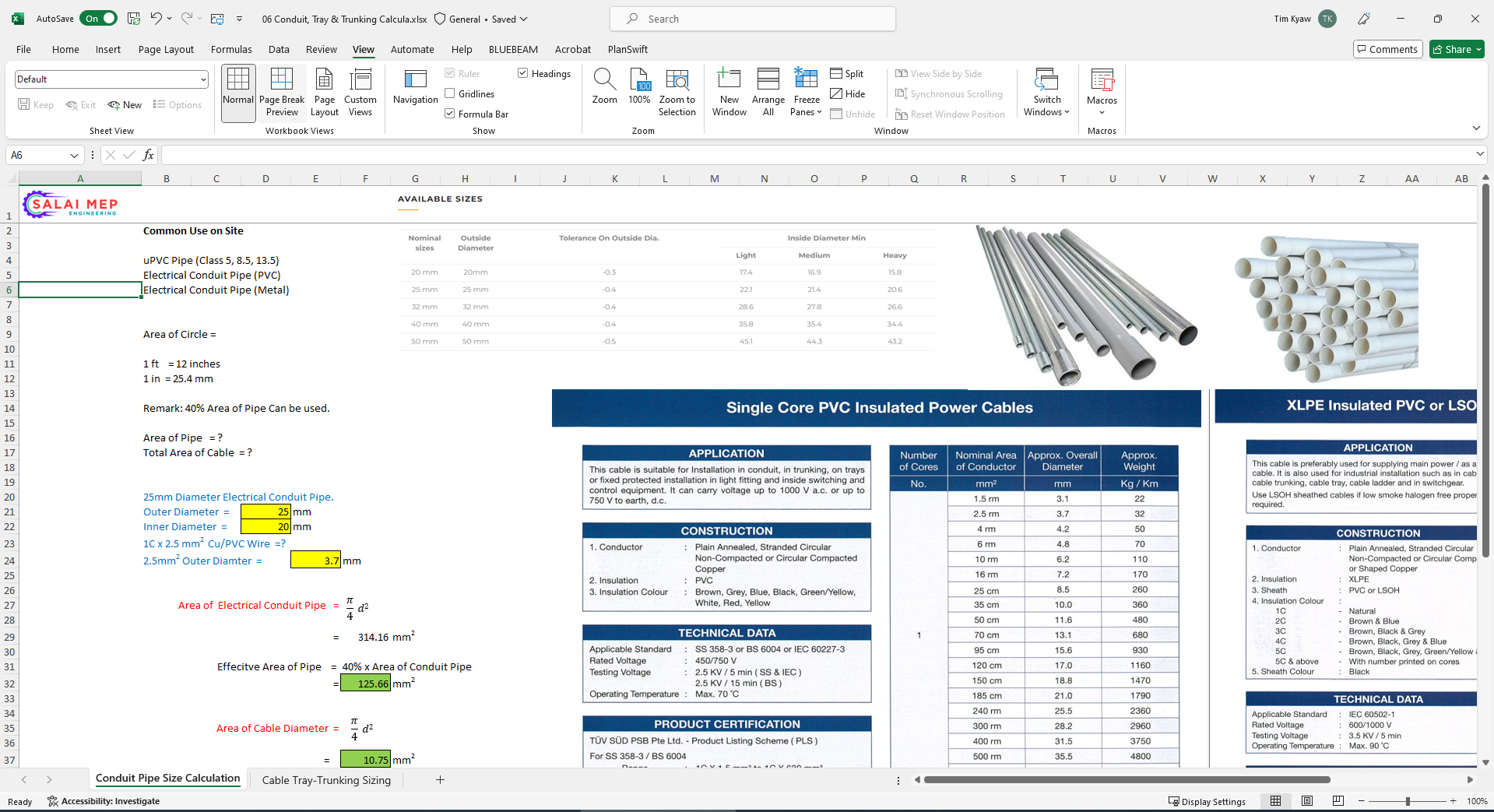Conduit pipe sizing is a crucial aspect of electrical system design, ensuring that electrical cables are safely and efficiently routed through a building or installation. Proper conduit sizing helps prevent overheating, allows for easier cable pulling, and ensures compliance with electrical codes and standards. Here’s a detailed guide on how to size conduit pipes, including relevant codes, methods, and examples:
Steps for Conduit Pipe Sizing
01. Determine the Total Cross-Sectional Area of Cables
- Calculate the cross-sectional area of each cable to be run through the conduit.
- Sum the cross-sectional areas to find the total area.
02. Select Conduit Fill Ratio:
- According to the National Electrical Code (NEC) or other relevant standards, choose the appropriate fill ratio. For example:
- 53% fill for a single cable.
- 31% fill for two cables.
- 40% fill for three or more cables.
03. Choose Conduit Size:
- Refer to conduit sizing tables that correlate the total cross-sectional area and fill ratio to the appropriate conduit size.
Relevant Standards and Codes
01 National Electrical Code (NEC):
- The NEC provides guidelines on conduit sizing, fill percentages, and installation practices.
- NEC Table 1, Chapter 9 outlines the maximum fill percentages for different types of conduits.
International Electrotechnical Commission (IEC):
- IEC standards may also be applicable, especially in non-U.S. regions, providing similar guidelines for conduit sizing.
Example Calculation
Step-by-Step Example:
Calculate Cross-Sectional Area of Cables:
- Suppose you have three cables with diameters of 0.5 inches, 0.75 inches, and 1 inch.
- Calculate the cross-sectional area (A) of each cable using the formula for the area of a circle: 𝐴=𝜋×(𝑑/2)2A=π×(d/2)2.
- Cable 1: 𝐴=3.14×(0.5/2)2=0.196 in2A=3.14×(0.5/2)2=0.196 in2
- Cable 2: 𝐴=3.14×(0.75/2)2=0.442 in2A=3.14×(0.75/2)2=0.442 in2
- Cable 3: 𝐴=3.14×(1/2)2=0.785 in2A=3.14×(1/2)2=0.785 in2
- Total Area: 0.196+0.442+0.785=1.423 in20.196+0.442+0.785=1.423 in2
Determine Fill Ratio:
- For three or more cables, the NEC allows a 40% fill ratio.
Select Conduit Size:
- Using NEC tables, find the smallest conduit size that can accommodate a 1.423 in² fill at 40% fill ratio.
- According to NEC Table 4, a 2-inch conduit has a total area of 3.356 in². At 40% fill, the usable area is 1.342 in².
- Since 1.423 in² exceeds 1.342 in², you need a larger conduit.
- A 2.5-inch conduit has a total area of 5.826 in². At 40% fill, the usable area is 2.330 in².
- 1.423 in² fits within 2.330 in², so a 2.5-inch conduit is appropriate.
Tools for Conduit Sizing
Conduit Sizing Calculators:
- Online calculators can simplify the process by allowing you to input cable sizes and automatically calculating the required conduit size.
Software Solutions:
- Electrical design software such as Autodesk Revit, ETAP, or electrical CAD programs often have built-in tools for conduit sizing.
Common Conduit Types and Sizes
01 Electrical Metallic Tubing (EMT):
- Sizes range from ½ inch to 4 inches in diameter.
- Commonly used in commercial and industrial applications for indoor installations.
02 Rigid Metal Conduit (RMC):
- Sizes range from ½ inch to 6 inches.
- Provides maximum protection for cables and is used in severe environments.
03 PVC Conduit:
- Sizes range from ½ inch to 6 inches.
- Suitable for underground or wet location installations.
Conclusion
Proper conduit sizing is essential for safe and efficient electrical installations. By following the steps outlined, using the appropriate standards and codes, and leveraging tools and software, you can ensure that your conduit systems are correctly sized. This not only helps in compliance with electrical codes but also enhances the safety and reliability of the electrical system.
Note: All Password are [“salaimep” or “salaimep.com”]
Download |OneDrive
Also Download – Cable Trunking Sizing Excel & Cable Ladder or Cable Tray Sizing Excel










fgfdgd